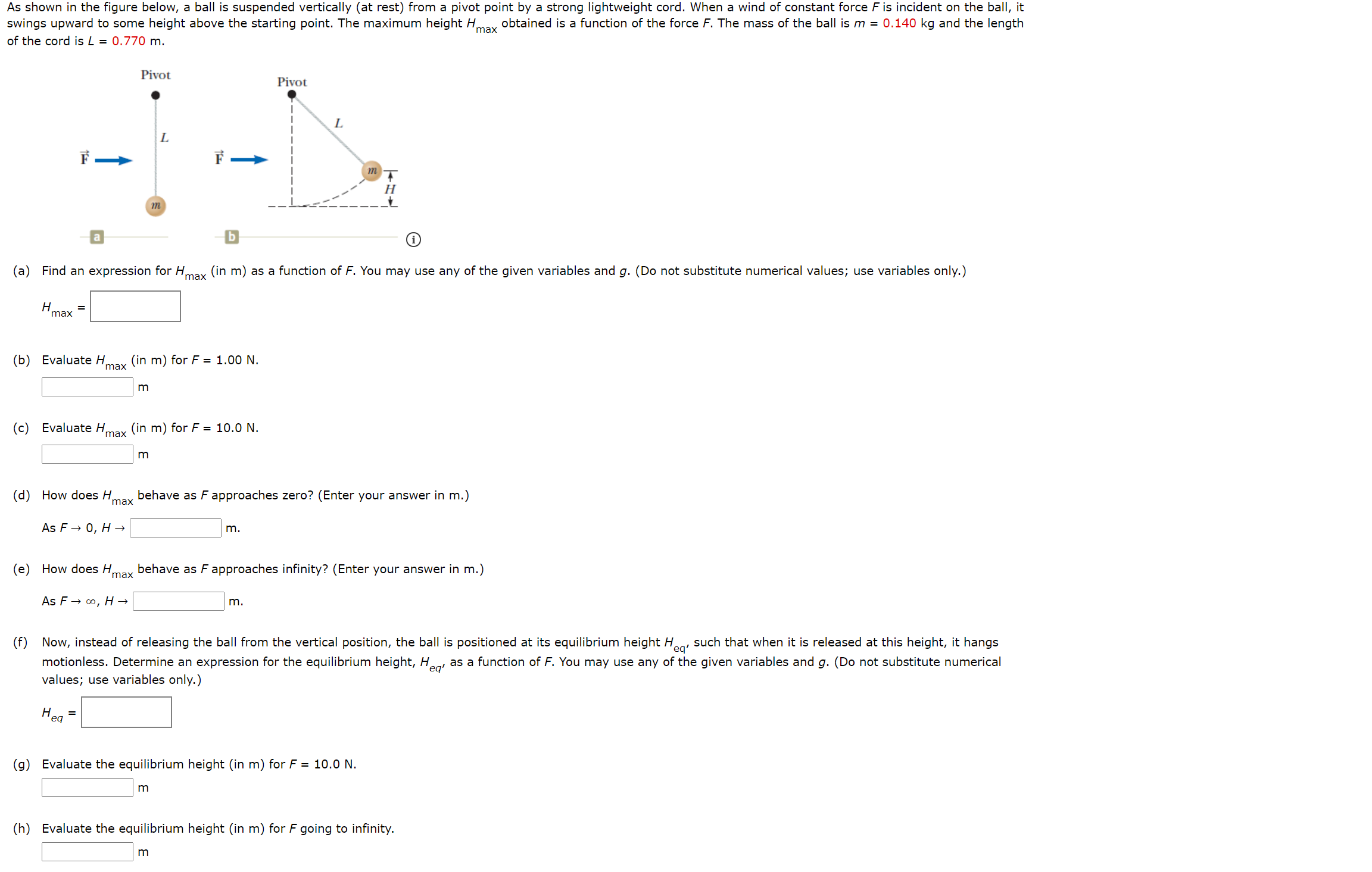As shown in the figure below, a ball is suspended vertically (at rest) from a pivot point by a strong lightweight cord. When a wind of constant force F is incident on the ball, it swings upward to some height above the starting point. The maximum height H, obtained is a function of the force F. The mass of the ball is m = 0.140 kg and the length max of the cord is L = 0.770 m. Pivot Pivot L L F - m H (a) Find an expression for H, (in m) as a function of F. You may use any of the given variables and g. (Do not substitute numerical values; use variables only.) max H. max (b) Evaluate H (in m) for F = 1.00 N. max (c) Evaluate H, (in m) for F = 10.0 N. max
As shown in the figure below, a ball is suspended vertically (at rest) from a pivot point by a strong lightweight cord. When a wind of constant force F is incident on the ball, it swings upward to some height above the starting point. The maximum height H, obtained is a function of the force F. The mass of the ball is m = 0.140 kg and the length max of the cord is L = 0.770 m. Pivot Pivot L L F - m H (a) Find an expression for H, (in m) as a function of F. You may use any of the given variables and g. (Do not substitute numerical values; use variables only.) max H. max (b) Evaluate H (in m) for F = 1.00 N. max (c) Evaluate H, (in m) for F = 10.0 N. max
Classical Dynamics of Particles and Systems
5th Edition
ISBN:9780534408961
Author:Stephen T. Thornton, Jerry B. Marion
Publisher:Stephen T. Thornton, Jerry B. Marion
Chapter9: Dynamics Of A System Of Particles
Section: Chapter Questions
Problem 9.19P
Related questions
Question
100%
HELP NO COMPRENDO

Transcribed Image Text:As shown in the figure below, a ball is suspended vertically (at rest) from a pivot point by a strong lightweight cord. When a wind of constant force F is incident on the ball, it
swings upward to some height above the starting point. The maximum height H,
obtained is a function of the force F. The mass of the ball is m = 0.140 kg and the length
max
of the cord is L = 0.770 m.
Pivot
Pivot
L
L
F -
m
H
(a) Find an expression for H,
(in m) as a function of F. You may use any of the given variables and g. (Do not substitute numerical values; use variables only.)
max
H.
max
(b) Evaluate H
(in m) for F = 1.00 N.
max
(c) Evaluate H,
(in m) for F = 10.0 N.
max
Expert Solution
This question has been solved!
Explore an expertly crafted, step-by-step solution for a thorough understanding of key concepts.
This is a popular solution!
Trending now
This is a popular solution!
Step by step
Solved in 3 steps with 5 images

Knowledge Booster
Learn more about
Need a deep-dive on the concept behind this application? Look no further. Learn more about this topic, physics and related others by exploring similar questions and additional content below.Recommended textbooks for you

Classical Dynamics of Particles and Systems
Physics
ISBN:
9780534408961
Author:
Stephen T. Thornton, Jerry B. Marion
Publisher:
Cengage Learning

Classical Dynamics of Particles and Systems
Physics
ISBN:
9780534408961
Author:
Stephen T. Thornton, Jerry B. Marion
Publisher:
Cengage Learning